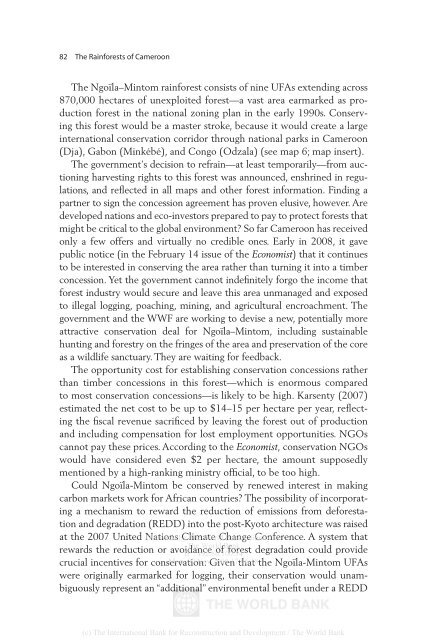The Rainforests of Cameroon - PROFOR
The Rainforests of Cameroon - PROFOR
The Rainforests of Cameroon - PROFOR
- No tags were found...
You also want an ePaper? Increase the reach of your titles
YUMPU automatically turns print PDFs into web optimized ePapers that Google loves.
82 <strong>The</strong> <strong>Rainforests</strong> <strong>of</strong> <strong>Cameroon</strong><strong>The</strong> Ngoïla–Mintom rainforest consists <strong>of</strong> nine UFAs extending across870,000 hectares <strong>of</strong> unexploited forest—a vast area earmarked as productionforest in the national zoning plan in the early 1990s. Conservingthis forest would be a master stroke, because it would create a largeinternational conservation corridor through national parks in <strong>Cameroon</strong>(Dja), Gabon (Minkébé), and Congo (Odzala) (see map 6; map insert).<strong>The</strong> government’s decision to refrain—at least temporarily—from auctioningharvesting rights to this forest was announced, enshrined in regulations,and reflected in all maps and other forest information. Finding apartner to sign the concession agreement has proven elusive, however. Aredeveloped nations and eco-investors prepared to pay to protect forests thatmight be critical to the global environment? So far <strong>Cameroon</strong> has receivedonly a few <strong>of</strong>fers and virtually no credible ones. Early in 2008, it gavepublic notice (in the February 14 issue <strong>of</strong> the Economist) that it continuesto be interested in conserving the area rather than turning it into a timberconcession. Yet the government cannot indefinitely forgo the income thatforest industry would secure and leave this area unmanaged and exposedto illegal logging, poaching, mining, and agricultural encroachment. <strong>The</strong>government and the WWF are working to devise a new, potentially moreattractive conservation deal for Ngoïla–Mintom, including sustainablehunting and forestry on the fringes <strong>of</strong> the area and preservation <strong>of</strong> the coreas a wildlife sanctuary. <strong>The</strong>y are waiting for feedback.<strong>The</strong> opportunity cost for establishing conservation concessions ratherthan timber concessions in this forest—which is enormous comparedto most conservation concessions—is likely to be high. Karsenty (2007)estimated the net cost to be up to $14–15 per hectare per year, reflectingthe fiscal revenue sacrificed by leaving the forest out <strong>of</strong> productionand including compensation for lost employment opportunities. NGOscannot pay these prices. According to the Economist, conservation NGOswould have considered even $2 per hectare, the amount supposedlymentioned by a high-ranking ministry <strong>of</strong>ficial, to be too high.Could Ngoïla-Mintom be conserved by renewed interest in makingcarbon markets work for African countries? <strong>The</strong> possibility <strong>of</strong> incorporatinga mechanism to reward the reduction <strong>of</strong> emissions from deforestationand degradation (REDD) into the post-Kyoto architecture was raisedat the 2007 United Nations Delivered by Climate <strong>The</strong> World Change Bank e-library Conference. to: A system that<strong>The</strong> World Bankrewards the reduction or avoidance IP : 192.86.100.34 <strong>of</strong> forest degradation could providecrucial incentives for conservation: Mon, 09 Nov Given 2009 17:06:18 that the Ngoïla-Mintom UFAswere originally earmarked for logging, their conservation would unambiguouslyrepresent an “additional” environmental benefit under a REDD(c) <strong>The</strong> International Bank for Reconstruction and Development / <strong>The</strong> World Bank
















